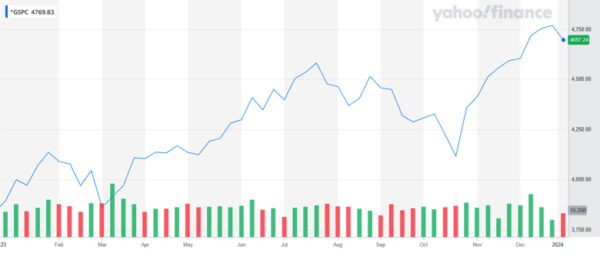The beginning of a new year is always a good time to review and readjust your investment portfolio. We have just gone through an extraordinary climb in the market, represented here by the S&P 500, in a relatively short period of time. However, as you can see, it is not without its downturns.

What is next? The Federal Reserve’s Open Market Committee indicated that rate decreases will be forthcoming in 2024. Unemployment is relatively stable, and inflation appears to be on a decline.
What to Expect in 2024
According to a recent article in Forbes, the S&P 500 generated a total return of 26.29% in 2023, rebounding from an 18.11% decline in 2022, a dismal year in financial markets. Some economic forecasters call for continued market growth in 2024 while others suggest a slowdown in growth to mid-single digits. What should investors do?
I like the advice of Warren Buffett, a wise and successful investor – target slow and steady wealth growth. His advice encompasses many aspects of investing.
Warren Buffett’s 7 Tips
An article published on GOBankingRates.com[i], lists seven of Buffet’s pieces of advice.
- Invest in What You Understand
- The Power of Compound Interest
- Be Fearful When Others are Greedy
- Value Investing
- Avoid Excessive Debt
- Reinvest Your Profits
- Keep a Long-Term Perspective
Although Buffett refers to a selection of individual stocks, his advice is especially relevant for beginner investors where mutual funds or exchange-traded funds may be more applicable. Let’s take a deeper dive into a couple of his tips in that context.
Invest in What You Understand
There is so much to understand about financial markets in general. Add to that the need to select individual investments. It can be overwhelming. It is not impossible, however. The solution depends on how much time you want to devote to your portfolio.
A good place to start is to read my book for beginning investors: How to Dress a Naked Portfolio, and sign up to receive my latest blogs. When you sign up for my email, you will receive The Eight Essential Investing Questions. If you have a good understanding of your goals and investing style, your investment selections will not only be easier but will work together to develop wealth over the long-term.
These blogs may also help you get started: Your First Financial Step, The Key to Investing – Know Yourself, What is Your Investing Style, Asset Allocation = Investment Chili, Mutual Funds, and Exchange-Traded Funds. None take more than a few minutes to read. If you have a question about any of the topics of my blogs, please send me an email.
Keep a Long-Term Perspective
Investing is for long-term goals, those that are at least seven years out on the horizon. That time frame allows for up and down years in the financial markets and for growth, which is the reason we invest. What are the benefits of long-term investing?
- Growth: More time for your portfolio to potentially benefit from compound interest.
- Smoother: The ability to ride out short-term stock market volatility.
- Fewer emotions: Help you avoid any hasty decisions in reaction to market movements.
- Time effective: Long-term investment is time effective and does not require intensive research to get started.
- Cost saving: If you’re an infrequent trader, you can buy and hold to reduce associated commissions and other costs.
- Tax saving: Long-term investing offers numerous benefits that can help you achieve your financial goals despite short-term volatility.
After you review the great resources available and get started investing, don’t forget to check back regularly. If you become concerned about market moves, read my blogs – Financial Vigilance and Market Anxieties and Fears. Don’t panic if you have not started to invest and you are not that far from retirement. Both my book and Mid-Life Panic address that possibility.
A future blog will cover growth and value investing and their differences so sign up for my emails today!
Beverly J Bowers, CFP®



